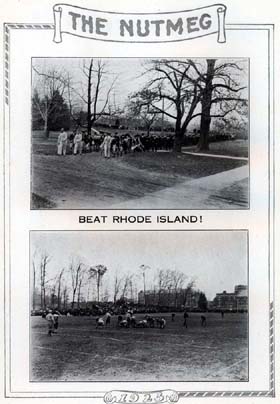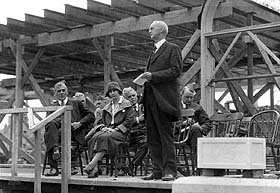|
This is an archived article.
For the latest news, go to the
Advance Homepage For more archives, go to the Advance Archive/Search Page. | |||||||
|
Homecoming
Becomes a Tradition
Originally part of Commencement weekend - including, at times, a baseball game against alumni - the annual reunion has been a time when selected classes of graduates are urged to come back to campus to remember old times, rekindle old friendships, and view the changes on the Storrs campus. In the 1920s, however, the Alumni Association found the need to bring back alums in the fall as well - and Homecoming was born. Even before the official start of Homecoming in 1925, there were fall "reunions" held in 1922 and 1924. The first of these was announced in one of the first issues of the alumni newsletter, The Connecticut Alumnus, the forerunner of today's UConn Traditions magazine. Alumni were urged to attend the annual football game versus Rhode Island, and cheerleaders led a parade of students and alumni to the football field. But the Connecticut "Aggies" (we didn't become the Huskies until 1934) lost the Nov. 18, 1922 game, 12 to 7. Another fall reunion was called for two years later - also at the annual football game versus Rhode Island. And it included another alumni and student parade that formed in front of Old Main - the three-story wooden structure that was the main college building from 1890 until 1929 - and marched to Gardener Dow Field behind Hawley Armory. The football field was then about where the Babbidge Library is today. After one lap around the football field, the parade of alumni and students went to the bleachers to watch Connecticut defeat the Rams 22 to 0. It ended Connecticut's first undefeated football season and Sumner Dole's second year as head coach. By the fall of the next year, the Alumni Association was ready to announce a new tradition of Homecoming: "With the fall of the year and the opening of school there comes to every college man or woman the thought of football and the desire to return to their Alma Mater to witness at least one of the important football games of the season," said a front-page article in the September 1925 issue of the Alumnus. "The Homecoming Day is not put on for the student body, faculty, or football team, but for you," said the Alumnus. "And you won't want to miss your own Homecoming Day this fall for several reasons." The main reason cited was the annual football game versus Massachusetts Agricultural College (today University of Massachusetts) - "sure to be a thriller," noted the Alumnus. Hundreds of alumni and former students returned to their Alma Mater on Oct. 17 to celebrate the first annual Homecoming Day. Hundreds of returning alums was a considerable success, considering that, by 1924, the then-Connecticut Agricultural College had fewer than 700 graduates. Student enrollment in 1925 was 516, with about 50 faculty. The first official Homecoming included a ceremony presided over by President Charles L. Beach to lay the cornerstone for the Community House at the Storrs Congregational Church. The building would serve as a central location for student activities and events until the early 1950s, when the Student Union was built. The result of the first Homecoming football game was not a joyous one for Connecticut: Massachusetts won the game, 13- 0. There is no mention of an alumni-student parade for the 1925 event, but that evening "the co-eds held a dance in honor of the returning alumni, many of whom remained on the 'Hill' until a late hour." At the time, much of the small campus was along the top of the rise up from Route 195, and students and alumni referred to Connecticut Agricultural College as "the Hill" during the first six decades of its existence. Over the next decade, Homecoming was usually held in November, generally the weekend of the Connecticut-Rhode Island game. In the 1930s, it was held in conjunction with the campus observance of Armistice Day, the day marking the end of World War I. The first combined Armistice-Homecoming Day was Nov. 4, 1933. It included a memorial service to remember the seven Connecticut alumni who died during the First World War. It also served as a memorial service for President Emeritus Charles L. Beach, who had died Sept. 15. The combined event continued for about five years. Since the 1950s, Homecoming has been held in late October, and has included a variety of events, including the annual parade through the campus. Mark J. Roy |
 ince the founding of the Alumni Association in 1888, there
has been a reunion in Storrs every June. But the tradition of
Homecoming didn't begin until the 1920s.
ince the founding of the Alumni Association in 1888, there
has been a reunion in Storrs every June. But the tradition of
Homecoming didn't begin until the 1920s.


